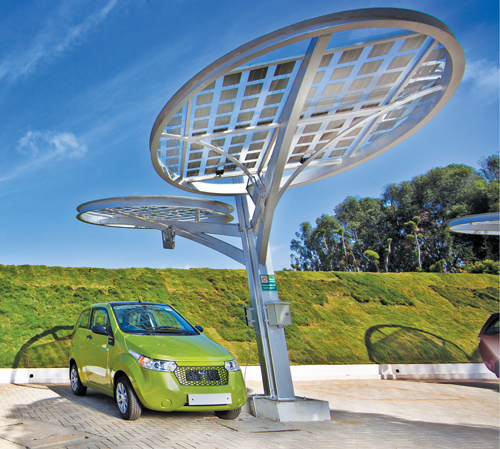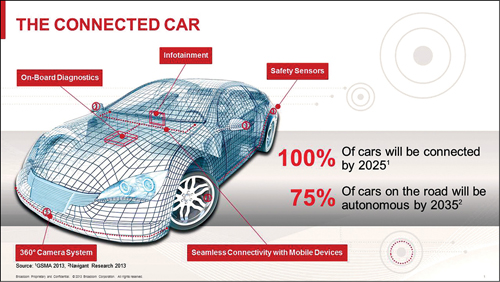My car, my guide
One look at a modern car’s dashboard is enough to show the amount of vehicle management and driving assistance features are there in it! Advanced driver assistance systems (ADAS) are beginning to feature in many new-gen cars. A blanket term that covers everything from GPS-based navigation aids and traffic updates to adaptive cruise control (ACC), lane departure warning, blind spot detection, collision avoidance, speed adaptation and night vision, ADAS basically covers a growing number of tools that improve situational awareness and understand the driver’s temperament and automate routine tasks to make driving more convenient and safe.

“Automakers are trying hard to match consumer experience in cars to what they get using smartphones and tablets. This has resulted in high-end infotainment technologies getting integrated into today’s cars. The focus on driver and passenger safety is driving developments in ADAS, based on radar and vision, super data fusion technologies to name a few,” says Sanjay Gupta, director—Automotive MCU Group, India Design Centre, Freescale Semiconductors India Pvt Ltd. He cites some interesting examples, such as Volvo’s City Safety, a low-speed crash avoidance system available with its XC60 crossover SUV. The detection system uses LIDAR, a cross between laser and radar, to prevent fender-benders below 14.5 kmph.
ACC is also emerging strong. Toyota, Ford, Mercedes and Jaguar already offer this facility on some vehicles. It tracks the car ahead, slowing down and speeding up automatically to maintain a safe distance in variable highway traffic.
“Our 77GHz radar systems support ACC, pre-crash protection and collision warning systems with and without automatic steering and braking intervention. In a collision warning system, the radar chipset can detect and track objects, automatically adjusting the vehicle’s speed and distance in response to the traffic ahead and triggering a driver warning of an imminent collision and initiate emergency braking intervention,” explains Gupta.

Although still expensive, today we also have technologies that sense when the driver is too tired to drive or has had too much to drink. Volvo, for instance, uses available lane departure sensing technology to detect when sleepy drivers make jerky, telltale steering wheel corrections. The system then audibly suggests that the driver pull over and take rest.
Ford has an interesting emergency assist feature that connects vehicle occupants with emergency services in the misfortune of an accident, providing vehicle location and an open line for communication. “Ford India is the first auto manufacturer and EcoSport is the only vehicle in its segment to offer a potentially life-saving emergency assistance system. This is a vehicle-based, no-cost, non-subscription call-for-help system that is already available in more than five million Ford vehicles globally. The service is provided free of charge for the ownership cycle of the vehicle,” says Vinay Piparsania, executive director, Marketing, Sales and Service, Ford India.
“The ability to determine an available parking space along a roadway, and back in automatically, with no more effort from the driver than the push of a button is being demonstrated by OEMs today,” says Tim Lau, associate product line director, Automotive, Broadcom.
Mahindra Reva’s new cars feature another interesting aspect called Feedback Orientation. “Since the car is not an isolated object but a part of a system, we are able to get feedback on its performance. The car is able to tell the driver how he is driving, and compare the performances over a period of time, so that the driver can tweak his driving style for efficiency,” says Chetan Maini, chief executive officer, Mahindra Reva Electric Vehicles Pvt Ltd.
As ADAS gets more advanced and reliable, it has started to induce some amount of autonomy in cars. Whilst it is still not possible to put a car on auto-drive mode and sit back, next-gen cars will surely let the driver relax and chat while driving. “Automated driving technology, being demonstrated now, will be available as an option on actual models within a few years. It takes control of cars for brief periods.
The technology, which uses a series of camera, radar, laser and ultrasonic sensors ‘to become aware of its surroundings,’ will relieve drivers of certain tasks—such as keeping a car in lane while rolling down a highway at a steady speed. Ultimately, the technology could take over for the driver in stop-and-go traffic including total control of steering, braking and accelerating. Industry analysts have forecast that 75 per cent of cars on the road will be autonomous by 2035,” explains Lau.
More updates.
-
- Audi’s new Traffic Light Assist system combines the car’s GPS navigation system with a city’s traffic light information system to let the driver know in advance simply how much time he has to zip past an approaching signal on his route before it turns red. The car maker is testing the system in certain developed nations.












